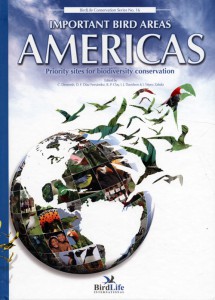Important Bird Areas: Americas
 “One of BirdLife International’s core research activities over recent years has centred on developing an Important Bird Area (IBA) network worldwide. The publication of ‘IBAs Americas’ represents a major milestone in this project. It is the culmination of 15 years of work by 72 partner organizations and over 3000 people to identify and document the most important sites for birds and biodiversity conservation in a region covering all of North America, Central America and, most ambitiously, South America – the ‘bird continent’, where one-third of the Earth’s avian species occur.
“One of BirdLife International’s core research activities over recent years has centred on developing an Important Bird Area (IBA) network worldwide. The publication of ‘IBAs Americas’ represents a major milestone in this project. It is the culmination of 15 years of work by 72 partner organizations and over 3000 people to identify and document the most important sites for birds and biodiversity conservation in a region covering all of North America, Central America and, most ambitiously, South America – the ‘bird continent’, where one-third of the Earth’s avian species occur.
It takes the form of a comprehensive directory of 2345 sites identified in all 57 countries and territories, covering more than 3.25 million km2. The aim of the book is to provide a concise summary of these sites, and an overview of the opportunities they provide for biodiversity conservation. In general, this is achieved very well, and very attractively, as the final product is beautifully organized and liberally illustrated with detailed maps and stunning colour photographs.
If I had to put my finger on my only misgivings about the project, I would point to the practical obstacles of applying a site-based method to complex ecosystems such as Neotropical rainforests. The IBA approach seems tailor-made for developed nations, where biodiversity is largely restricted to patches of natural habitat embedded in human-modified landscapes, and where we often know fairly well what each patch contains in terms of species and populations. In contrast, the IBA maps of poorly developed regions seem to align, not with the distribution of biodiversity per se, but the happenstance of data availability. In Amazonia or the Andes, for example, IBAs tend to align closely with sites targeted by existing conservation actions, or else visited by expeditions or birdwatchers, whereas many remote regions are missing even though they appear to offer better habitat and better prospects for long-term conservation. The result is that the IBA map in such regions is often a better guide to accessibility than to importance for birds.There is a need to acknowledge that temperate-zone strategies may not work so well in such cases, and that the IBA approach may be less effective than regional conservation strategies based on habitat classifications and remote sensing data.
A similar argument applies to the quality of status or population data, which again is often poor in tropical ecosystems. As such, it is generally difficult to know whether a species listed for a particular tropical IBA occurs locally in numbers sufficient for long-term conservation. These caveats aside, ‘IBAs Americas’ is an impressive reference work embodying a huge amount of effort, and a major contribution to biodiversity conservation in a crucial region. It provides an excellent summary of current knowledge regarding many sites destined to play a key role in the fight to preserve rare species from extinction, deserves widespread acclaim and a space on the bookshelf of anyone interested in New World birds and their conservation.”
Joseph M. Tobias,
IBIS The International Journal of Avian Science
